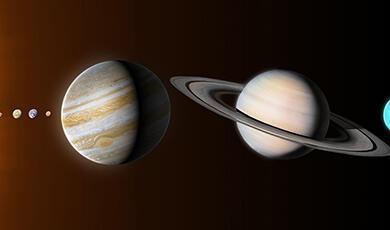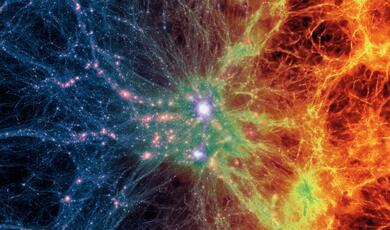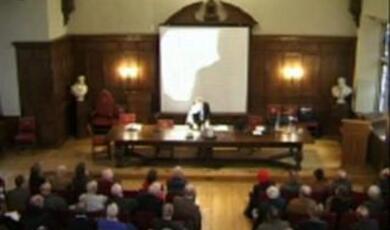How Common is Life in the Universe?
Share
- Details
- Transcript
- Audio
- Downloads
- Extra Reading
The discovery of exoplanets and of Earth twins will be described, with a review of attempts to estimate the probability of finding life in the universe - for example how many stars do we need to survey to find suitable planets? How much time is needed to generate life?
The FERMI paradox: where are the aliens? will be considered including water and oxygen as essential components of life, and searches for the signatures of life on distant planets. Chlorophyll could be a signature of plant life as pollution such as smog can be a signature of intelligent life.
Is searching for electronic signals from remote civilizations a futile activity? As advanced civilizations exhaust their planetary energy resources, how might one tackle a future energy crisis?
A short introduction to the topic of this lecture is offered in the following short video by Professor Joseph Silk:
Download Transcript
02 March 2016
How Common is Life in the Universe?
Professor Joseph Silk
I will describe the discovery of exoplanets and of Earth twins. I will review attempts to estimate the probability of finding life in the universe, for example how many stars do we need to survey to find suitable planets? How much time is needed to generate life? I will describe the FERMI paradox: where are the aliens? Water and oxygen are essential components of life: I will describe searches for the signatures of life on distant planets. Chlorophyll could be a signature of plant life. A signature of intelligent life could be pollution such as smog. Is searching for electronic signals from remote civilizations a futile activity, given the likely advances in technology? As advanced civilizations exhaust their planetary energy resources, how might one tackle a future energy crisis?
Where are they? Physicist Enrico Fermi famously asked this question in 1950, to express his surprise over the absence of any signs for the existence of other intelligent civilizations in the Milky Way galaxy. It occurred over a lunch at Los Alamos with three colleagues, whose written recollections are the only surviving record of Fermi's question.
While many potential resolutions to this so-called "Fermi Paradox" have been suggested over the years, there is still no consensus on which one, if any, is correct. The question of whether we are "alone" in the Milky Way (or in the universe at large) remains, however, one of the most intriguing questions in science in general, and in astronomy in particular.
Given the enormous uncertainties involved with the emergence, evolution, and survivability of any extrasolar life (if it exists), I shall attempt to briefly identify the most generic detectable signatures of an alien life (simple and intelligent), and to examine the expected effectiveness of various search strategies.
This topic has become particularly timely, since observations (primarily with the Kepler space observatory) have shown that the Milky Way contains no fewer than a billion Earth-size planets orbiting Sun-like (or smaller) stars in the "Goldilocks" region that allows liquid water to exist on the planet's surface (the so-called Habitable Zone). The Earth and Mars lie in this zone, but the planets Mercury and Jupiter do not. Furthermore, the search for extra-terrestrial intelligent life has recently received a significant boost in the form of "Breakthrough Listen" - a $100-million decadal project aimed at searching for non-natural transmissions in the bandwidth from 100MHz to 50 GHz.
The search is intensifying for twins of the Earth. These are planets in the habitable zone that are comparable in mass to the earth. A lighter planet, and Mars is an example, would not be able to retain its atmosphere for billions of years. Closer planets to the sun would be too hot and outer ones too icy for life to be likely. More problematically, the planets far from the sun are largely formed of gases such as methane, the rocky core characteristic of the earth forming at the high temperatures closer to the sun where the relatively toxic gases are too volatile to condense. Hitherto only a handful have been found, out of the 3000 or more exoplanets.
Planets close to their parent star are simply harder to find. The original technique used to find the first exoplanet made use of tiny periodic variations in radial velocity of the host star, caused by the presence of orbiting massive planets. A second method uses the transit of the planet in front of the parent star to produce a tiny diminution of the starlight. The most exciting is direct imaging, which requires cancelation of the light from the parent star either by light interference techniques or by insertion of a physical shade. All of these techniques are now being used.
The future holds particularly great promise for imaging of exoplanets. A 30 meter diameter starshade is being designed in the form of a sunflower that will unfurl its mylar petals in space near the WFIRST space telescope, a 2.4 meter telescope recently approved by NASA for launch around 2025. The idea is that the star shade will occult light from a nearby star and thereby suppress the light from the parent star by something like one part in a billion. This would enable the planetary system to be directly imaged.
Simple life on Earth appeared almost as soon as the Earth cooled sufficiently to support water-based organisms. However to be detectable from a distance, life has to evolve to the point where it dominates the planetary surface chemistry and has significantly changed the atmosphere. For instance, Earth itself would probably not have been detected as a life-bearing planet during the first two billion years of its existence. Concerning the evolution of intelligent life, the main open questions include: (i) what are the geochemical constraints on the evolution of complex life? (ii) what are the timescales that those constraints dictate? (iii) are there evolutionary 'filters' or bottlenecks that make it extremely hard to transit to intelligence?
On Earth, for example, it took about 3 billion years for the most basic multi-cellular life forms to appear. It took 4.5 billion years (and a series of contingencies such as plate tectonics and asteroid impacts) to reach even the most basic capability of interstellar communication (e.g. through radio reception and transmission). These considerations demonstrate that it is important to first establish whether planetary systems that are older than the solar system are common in the Milky Way.
The current age of the solar system is about half the age of the disk of our Galaxy, and also half of the Sun's total lifetime. We therefore expect that roughly one half of the stars in our Galactic disk are older than the Sun. A recent study that examined planet formation history concluded that the solar system formed close to the median epoch for giant planet formation, and that about 80% of currently existing Earth-like planets may have already existed at the time of the Earth's formation. This gives great leverage for probing extrasolar intelligent life. Imagine what a billion years advance on the Earth could generate for a surviving civilization.
Which detectable bio-signature may be considered the most reliable for the existence of simple life (on a sufficiently old, rocky planet, in the Habitable Zone)? While no single bio-signature would be absolutely compelling, an atmosphere that is very rich in oxygen (say at the >20% level) would probably be the most promising target initially. While non-biological processes (such as the splitting of carbon dioxide by intense ultraviolet radiation) can produce oxygen in a planetary atmosphere, only under rare circumstances will these create such high levels of enrichment. However, only in combination with other potential bio-signatures (e.g. extreme thermochemical disequilibrium involving chemical reduction and oxidation and leading to for example the simultaneous presence of molecular oxygen, which is highly oxidized, with methane, a highly reduced species) would the credibility of a life-based origin for the oxygen be significantly strengthened.
Consequently, an excellent first step in the quest for signatures of extrasolar simple life in the relatively near future would be: search for oxygen, but try to back it up with other bio signatures.
This can (in principle) be achieved with large, ground-based arrays of relatively low-cost flux collector telescopes (a next generation to the European Extremely Large Telescope; with a collecting area of a few football fields), if these are equipped with very high-dispersion (R=100,000) spectrographs.
The oxygen lines from the exoplanet's spectrum will be slightly Doppler-shifted relative to oxygen in the Earth's atmosphere. The more difficult detection of methane in the infrared would have to follow. From space, to place meaningful constraints on the existence of life requires that in the case of non-detection, one would need to at least say that remotely detectable life occurs in less than ~10% of Earth-like planets in the habitable zones of Sun-like stars.
This goal requires the ability to image and characterize the atmospheres of at least three dozen or so exo-Earths. This, in turn, would require a space telescope aperture exceeding 8 meters in diameter. The proposed Habitable-Exoplanet Imaging Mission (HabEx), under discussion for the next decadal survey, would have to be designed at the upper limit of its currently conceived aperture to meet this particular requirement, while the more futuristic 12 meter Large UV/Optical/IR (LUVOIR) space telescope would be a natural sequel in the 2030s.
One would ideally like to go beyond bio-signatures and seek the clearest sign of an alien technological civilization. This could be the unambiguous detection of an intelligent, non-natural signal, most notably through radio transmission, the aim of the SETI program.
Yet there is a distinct possibility that decipherable radio communication may be considered "archaic" to an advanced life form. Its duration would be short-lived, and hence rare over large volumes of the universe. What might then be a generic signature? Energy consumption is a hallmark of an advanced civilization that appears to be virtually impossible to conceal.
The two most plausible, long-term energy sources available to an advanced technology are through commanding stellar luminosity with a construction known as a "Dyson sphere", including potentially harvesting the starlight from many stars or even an entire galaxy, or through controlled fusion of hydrogen into heavier nuclei. In both cases, waste heat would be an inevitable outcome, with the consequence of the production of a detectable mid-infrared signature.
Other potential signatures of advanced civilizations that have been suggested, such as various forms of atmospheric industrial pollution, or short-lived radioactive products, are necessarily transitory (basically those aliens either clean up their act or destroy themselves). Infrared emission, on the other hand, seems almost unavoidable. A recent large survey by the Wide-field Infrared Survey Explorer (WISE) satellite did identify five red spiral galaxies whose combination of high mid-infrared and low near-ultraviolet luminosities are inconsistent with simple expectations from high rates of star formation. However a conventional explanation for these observations (e.g. through the presence of large amounts of internal dust) has not been ruled out. Such peculiar objects deserve follow-up observations before we explore whether they might represent the signatures of galaxy-dominating species.
More pessimistically, biologically-based intelligence may constitute only a very brief phase in the evolution of complexity, before what futurists have dubbed the "singularity" - the dominance of artificial, inorganic intelligence as described in Ray Kurzweil's 2005 book, The Singularity is Near.
If this is indeed the case, most advanced species are likely not to be found on the surface of a planet (where gravity is helpful for the emergence of biological life, but is otherwise a liability. But they probably must still be near a fuel supply, namely a star, because of energy considerations. Even if such intelligent machines were to transmit a signal, it would probably be non-recognizable and non-decodable to our relatively primitive, organic brains, which would perhaps explain the Fermi Paradox. If this scenario holds true, our chances of detecting simple life via bio signatures may be far greater than those of discovering ET. But the ultimate goal of detecting the signature of advanced intelligence (e.g. via IR emission from waste heat), whether biotic or abiotic, remains the most intriguing option.
All power to proposed projects for the 2020s such as JAXA's Space Infrared Telescope for Cosmology and Astrophysics (SPICA) and NASA's Far Infrared Surveyor.
The key point is that for the first time in human history, we are only two or three decades away from being able to actually answer the "are we alone?" question. Since the answer may affect nothing less than our last claim for being special in the cosmos, its importance cannot be overemphasized. In any case, we shall never know unless we search!
© Professor Joseph Silk, 2016
This event was on Wed, 02 Mar 2016
Support Gresham
Gresham College has offered an outstanding education to the public free of charge for over 400 years. Today, Gresham plays an important role in fostering a love of learning and a greater understanding of ourselves and the world around us. Your donation will help to widen our reach and to broaden our audience, allowing more people to benefit from a high-quality education from some of the brightest minds.


 Login
Login







